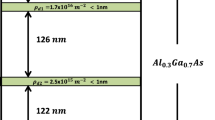Abstract
We provide a physical analysis of the charging and detection of the first few electrons in a laterally-coupled GaAs/AlGaAs quantum dot (LCQD) circuit with integrated quantum point contact (QPC) read-out. Our analysis is based on the numerical solution of the Kohn-Sham equation incorporated into a three-dimensional self-consistent scheme for simulating the quantum device. Electronic states and eigenenergy spectra reflecting the particular LCQD confinement shape are obtained as a function of external gate voltages. We also derive the stability diagram for the first few electrons in the device, and obtain excellent agreement with experimental data.
Similar content being viewed by others
References
1. D. Loss and D.P. DiVincenzo, “Quantum computation with quantum dots,” Physical Review A, 57(1), 120 (1998).
2. F.R. Waugh et al., “Single-Electron Charging in Double and Triple Quantum Dots with Tunable Coupling,” Physical Review Letters, 75(4), 705 (1995).
3. W.G. van der Wiel et al., “Electron transport through double quantum dots,” Review Modern Physics, 75(1), 1 (2003).
4. M. Ciorga et al., “Addition spectrum of a lateral dot from Coulomb and spin-blockade spectroscopy,” Physical Review B, 61(24), R16315 (2000).
5. J.M. Elzerman et al., “Few-electron quantum dot circuit with integrated charge read out,” Physical Review B, 67, 161308(R) (2003).
6. M. Field et al., “Measurments of coulomb blockade with a noninvasive voltage probe,” Physical Review Letters, 70(9), 1311 (1993).
7. D. Sprinzak et al., “Charge Distribution in a Kondo-Correlated Quantum Dot,” Physical Review Letters 88(17), 176805 (2002).
8. H. Pothier et al., “Single-Electron Pump Based on Charging Effects,” Europhysics Letters 17(3), 249 (1992).
9. W. Kohn and L. J. Sham, “Self-Consistent Equation Including Exchange and Correlation Effects,” Physical Review 140(4A), A1133 (1965)
10. J.P. Perdew and Y. Wang, “Accurate and simple analytic reprensentation of the electron-gas correlation energy,” Physical Review B, 45(23), 13244 (1992).
11. P. Matagne et al., “Modeling of the Electronic Properties of Vertical Quantum Dots by the Finite Element Method,” Computer Modeling in Engineering and Sciences(1), 1 (2000).
12. P. Matagne and J.-P. Leburton, “Three-dimensional analysis of the electronic structure of cylindrical vertical quantum dots,” Physical Review B, 65(23), 235323 (2002).
13. L.-X. Zhang et al., “Single-electron charging and detection in a laterally coupled quantum-dot circuit in the few-electron regime,” Physical Review B, 69(24), 245301 (2004).
14. J.C. Slater, Advances in Quantum Chemistry, 6, 1 (1972).
15. S. Nagaraja et al., “Electronic properties and spin polarization in coupled quantum dots,” Physical Review B 60(12), 8759 (1999)
Author information
Authors and Affiliations
Corresponding author
Rights and permissions
About this article
Cite this article
Zhang, L.X., Melnikov, D.V. & Leburton, JP. Simulation of Spin-Qubit Quantum Dot Circuit with Integrated Quantum Point Contact Read-Out. J Comput Electron 4, 111–114 (2005). https://doi.org/10.1007/s10825-005-7119-4
Issue Date:
DOI: https://doi.org/10.1007/s10825-005-7119-4




